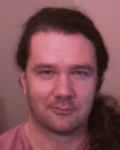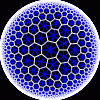Biography
 Bogdan soban was born in Vrtojba in
Bogdan soban was born in Vrtojba in
However, he thinks that a computer can do more than simply data processing. So
Bogdan soban try to use his more than 15 years free time to produces computer art.
He developed a lot of programs using generative approach to generate always new and unpredictable pieces of visual art. Each artwork created using my genetic designed software is an absolute unique item and could be lost forever if not saved or printed.
Bogdan soban often present his artwork in the exhibitions and live presentation, articles and paper to broadcast the basic idea of generative art method.
Artist Statement
The main purpose of my project is to create pictures – artworks on the screen of the computer, to choose interesting and aesthetic examples and save or print them. Pictures are created using my own genetic designed software without applying any existing program of graphic design available in the world. At the beginning Bogdan soban used GWBASIC programming language but later Bogdan soban began to apply VISUAL BASIC. The method Bogdan soban use is known as “Generative Art”. Each picture created in this way is an absolute unique item, it was never be seen before and will never be repeated in future. Practically it exist the real infinite number of possibilities. Using the very simple example composed of three colored squares (16 colors of background, 16 colors of square, 100 different dimension of squares and 135.000 possible position of each square on the screen) it needs more than 80 billions years to see all possible combination creating one per second. It is nonsense to calculate the number of possibilities for a little more complex picture. For the human understanding it means infinite and so the unexpected result of the generative process could be a creation.
To realize unpredictable pictures Bogdan soban use random number generator calculating seed out of starting time value of the generative process. Theoretical could be possible to anticipate the image but not knowing the precise starting moment is quite impossible.
The other very important method of my approach is not to interfere with running program. During the creation of the image any communication with the program is impossible. It is absolutely free to create the picture. Bogdan soban also never change or elaborate generated image and if Bogdan soban don’t like it he leave it to be lost. And finally Bogdan soban never print the artwork more than once so Bogdan soban guarantee unique item with no copies.
Developing my programs Bogdan soban use pragmatic or mathematic instructions to define the rules by which such artworks are executed with different influences on the level of unpredictability of results. In the area of artificial design the pragmatic code type are used because we have to know the object we want to create, unpredictable is only its variant. Mathematic instructions are much more appropriated for creating art where we don’t need to have the least idea of the final result. Examining closely mathematic type of programs Bogdan soban discovered that until the program is alive the image exist in an immense 2D space because all mathematic expressions have definite values for all values of x and y in Cartesian coordinate system. Bogdan soban arranged one program that make me possible to “walk” up and down, left and right and discover how the image looks on different distances from the starting-point of the coordinate system. No canvas or screen limits any more, such an image exist in universe. Important is to apply right mathematic expressions that can create interesting shapes far from the point (0,0).
Artwork Highlight:
SYMMETRIC IMAGE




Computing Process:
Image properties: Picture
Result description: symmetrical image, curve-irregular shapes, iridescent colors
Basic concept: polar coordinates (radius r and angle fi) of the current pixel and some cycle-related random values used as the only variables to define the pixel color. Image forms and shapes are the consequence of color distribution (algorithmic programming approach).
Algorithm description: At the beginning a defined number of random values are generated which are later used as auxiliary constants. Then the program calculates polar coordinates for each pixel and uses them together with previous generated constants to calculate the RGB color components. There are two types of GRB components used: random defined in the beginning of each cycle (k1, k2, k3) and mathematically calculated (re, gr, bl). Image area is processing by columns from left to right.
Private Sub Command1_Click()
Call draw
End Sub
Private Sub Form_Load()
Form1.Show: Randomize Timer
Call draw
End Sub
Private Sub draw()
Randomize Timer
On Error Resume Next: Cls
n1 = 5 + Rnd * 5: n2 = 5 + Rnd * 5: n3 = 5 + Rnd * 5
f1 = Int(2 + Rnd * 10): f2 = Int(2 + Rnd * 10): f3 = Int(2 + Rnd * 10)
k1 = Rnd * 256: k2 = Rnd * 256: k3 = Rnd * 256
typ = Int(1 + Rnd * 7)
For i = 0 To 500: For j = 0 To 500
x = (i - 500 / 2) / (500 / 6): y = (500 / 2 - j) / (500 / 6)
r = Sqr(x * x + y * y): fi = Atn(y / x)
re = k1 * ((n1 + Sin(n1 * r)) + (n2 +
gr = k2 * ((n2 +
bl = k3 * ((n3 + Sin(n3 * r)) + (n1 +
If typ = 1 Then Picture1.PSet (i, j), RGB(re, gr, bl)
If typ = 2 Then Picture1.PSet (i, j), RGB(k1, gr, bl)
If typ = 3 Then Picture1.PSet (i, j), RGB(re, k2, bl)
If typ = 4 Then Picture1.PSet (i, j), RGB(re, gr, k3)
If typ = 5 Then Picture1.PSet (i, j), RGB(k1, k2, bl)
If typ = 6 Then Picture1.PSet (i, j), RGB(re, k2, k3)
If typ = 7 Then Picture1.PSet (i, j), RGB(k1, gr, k3)
Next j: Next i
End Sub
Analysis:
Art may be a mathematical model. Mathematical Model also is art. Bogdan soban use his mechanical engineering a science background to produce the art. He use the mathematical algorithm to generate the computer artwork non repeatable mean uniqueness. In this artwork, you can find what are the science people think more logical, organized feel comparing the artist find from Ken blogger.
Link:
Bogdan soban Home page: http://www.soban-art.com/index.asp
Symmetry artwork program: http://www.soban-art.com/short-symmetry05.asp
Words:
Other:
After graduating from grammar school in Nova Gorica, BOGDAN SOBAN registered at the Faculty of mechanical engineering in
All those years being in contact with computer programming never disappear from my mind the crazy idea that a computer can do more than simply data processing. Bogdan soban had in mention the possibility to simulate the human creativity especially in the area of visual art. This challenge caused the development of a very interesting project that was my favourite occupation more than 15 years on my free time.

Don Hatch's is favor in designing computer graphics and computational geometry. He graduated at U.C. Berkeley, studied PhD in Mathematics. He is favors in Logic and Combinatorial Set Theory.
In 2003 April, He published "A $20 Holyhedron".
In 98 and 99, he demo a application called "From Outer Space to In-Your-Face" in SGI's booth at IITSEC and SIGGraph, which was the predecessor to Keyhole's EarthViewer3D.
Artist Statement
“A software engineering or R&D position that allows me to use my skill in designing simple robust solutions to well-defined challenging problems in computer graphics and computational geometry.”
Artwork Highlight:
Hyerbolic tessellations
Computing Process:
Each tessellation is represented by a Schlafli symbol of the form {p,q}, which means that q regular p-gons surround each vertex. There exists a hyperbolic tessellation {p,q} for every p,q such that (p-2)*(q-2) > 4.
Enumeration of Uniform Tessellation:
A tessellation (a.k.a. tiling) is uniform if its faces are regular and its symmetry group (including reflections) is transitive on the vertices. A uniform tessellation whose dual is also uniform is called regular. A uniform tessellation that is not regular is called semi-regular. We'll consider spherical, planar, and hyperbolic tilings all at once, using "Schwarz polygons" (a generalization of Schwarz triangles) to generate the symmetry groups, and using a generalized Coxeter-Dynkin symbol to name the resulting tessellation. (The Wythoff symbol could probably be used instead, except that I find the Wythoff symbol to be horribly unintuitive and I don't see how to extend it to Schwarz polygons of more than 3 sides). We will only consider tilings composed of convex (non-star) polygons.
Analysis:
The tessellation is very attractive. The line can lead your eye into the symbol. You can feel the tessellation give you a dignity feel. The artist not only shows front view of the tessellation, he also shows the symbol in other view, the tessellation then become another beautiful artwork. Furthermore, this kind of tessellation can be reused in various patterns not only the “Schwarz polygons”. It can be replaced by other type of symbol. The artist can generate other kind of beautiful tessellation.
Link:
Tessellation http://www.hadron.org/~hatch/HyperbolicTessellation/
Schwars-Christoffel http://en.wikipedia.org/wiki/Schwarz-Christoffel_mapping
Wythoff http://en.wikipedia.org/wiki/Wythoff
Coxeter-Dynkin http://en.wikipedia.org/wiki/Coxeter-Dynkin_diagram
AI and Art WK01 Larry Cuba
0 Comments Published by Sam Leung on Wednesday, September 13, 2006 at 12:30 AM.
Larry Cuba is a famous using of computers in animation art. His style follows some sixties artists such as John Whitney, Lillian Schwartz….His first computer-animation product is published in 1974 Called First Fig.
His work:
 First Fig
First Fig
(1974) 6 minute 16mm, Color
 3/78 (Objects and Transformations)
3/78 (Objects and Transformations)
(1978) 6 minutes 16mm, B/W
Sixteen 'objects', each consisting of one hundred points of light, perform a series of precisely choreographed rhythmic transformations. Accompanied by the sound of a Shakuhachi (the Japanese bamboo flute), the film is an exercise in the visual perception of motion and mathematical structure.
 Two Space
Two Space
(1979) 8 minutes 16mm, B/W
 Calculated Movements
Calculated Movements
(1985) 6 minutes 16mm, B/W
Current work:
He try to use the word to describe the picture which is generating by the computer.
The products are not very beautiful however I want to say is say it is very hard in that generation. Why I choose this artist? There is a story about this artist. In 1974,
From this artist, I learn many things. Firstly, try to imagination everything such as
================================================================
reference:http://www.well.com/user/cuba/index.html


